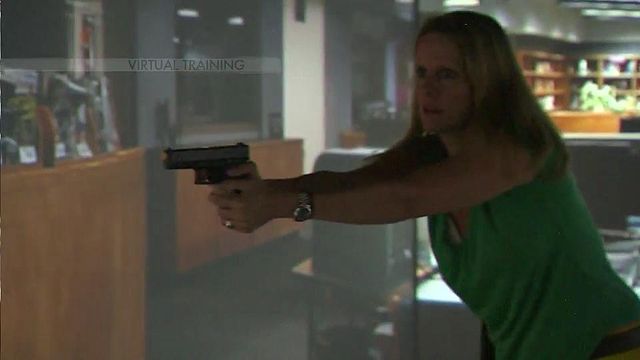WRAL Exclusive: Virtual police training teaches more than just when to shoot
What did I learn in training at the Tactical Defense Academy in Hickory? I learned something I already pretty much knew: Shooting a gun requires real training.
Posted — UpdatedWhen I was first assigned by my managers to go through the training at the Tactical Defense Academy in Hickory, I immediately thought, "you’ve got the wrong girl." Sure, I’m the crime reporter. I work with and cover law enforcement on a regular basis, but I am not trained to handle a gun. I have done plenty of stories at gun ranges and with gun owners in the 25 years I’ve been in television news, but have always done so as a voyeur and not as a participant. Not only that, but I’ve never played a video game in my life, so even the concept of “virtual” training made my palms sweat and my heart beat faster.
TDA owner and instructor Jeff Eddins immediately put my mind at ease. He explained that the gun was modified and would only contain cartridges of air that allowed it to simulate firing. At the end of the gun was a laser pointer that would connect with objects on the screen to simulate the ammunition hitting its target – in this case, bad guys. He walked me through a thorough safety briefing about how to load, hold and holster the gun as if it were real. And believe me, it felt real. He put my mind at ease about the experience, letting me know that because I was a novice, I would not have any preconceived notions about what to do, and I didn’t already have any bad habits I needed to shake.
What struck me right away was just how life-like the scenarios were. With five screens around me creating a 360-degree virtual landscape, I could be attacked and shot from behind at any moment. Even though in my head I knew that the whole thing was an exercise, I couldn’t help but panic when I heard the screams and the gunshots and saw the injured people all around me. While I had some success in getting the bad guys, I also hesitated enough times to be shot by a second shooter that I did not anticipate. I spent more time on the ground than on my feet, something that saw Eddins continually telling me to “get off the floor.”
I couldn’t believe how quickly I was supposed to be making these life-altering decisions: 1.3 seconds. Eddins said if someone was 20 feet or closer to me, that was the amount of time I had to discern if they had a weapon and could harm me, that’s how long it would take for them to be on top of me.
So, what did I learn? I learned something I already pretty much knew: Shooting a gun requires real training. Training a few hours in a virtual exercise can't compare. But perhaps most importantly I learned that police officers have one of the most difficult jobs in the world. Not only do they need to be skilled at handling a gun, but they have to make split-second, potentially life-altering decisions to save people’s lives, including their own with a clear head and absolute precision and accuracy. There are no re-dos in the real world like there are in the virtual universe. I can’t tell you how much stress these faux scenarios caused me, and I can’t imagine being in their shoes.
Eddins was generous in his positive feedback of my performance and gentle with his criticism. But ultimately, he said I achieved what I came for. I am a regular person who was put in impossible situations just long enough to know that the people who take an oath to protect others for a living deserve our support and respect.
Watch my exclusive report on this one-of-a-kind police training facility here in North Carolina Wednesday at 6 p.m. on WRAL-TV
Related Topics
• Credits
Copyright 2024 by Capitol Broadcasting Company. All rights reserved. This material may not be published, broadcast, rewritten or redistributed.






